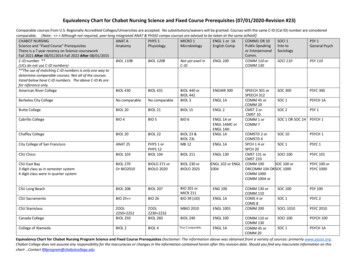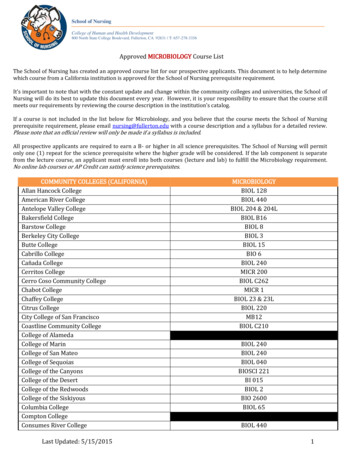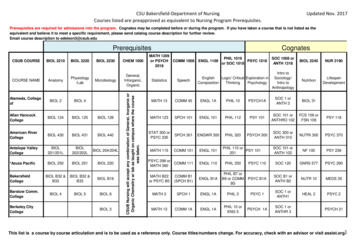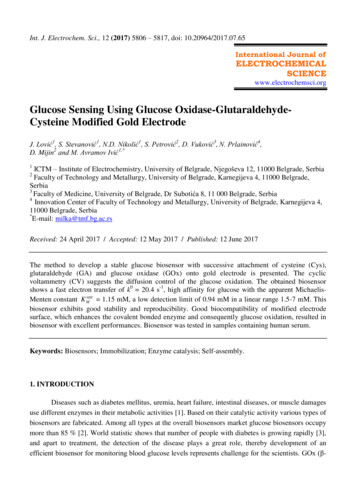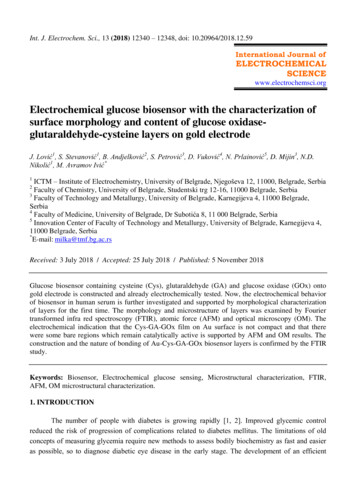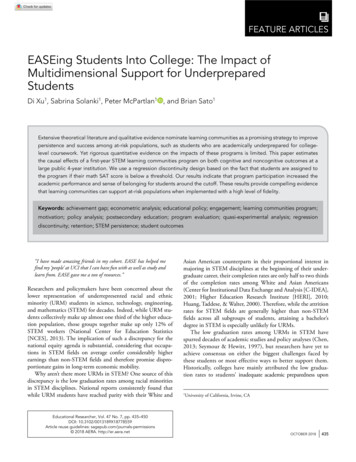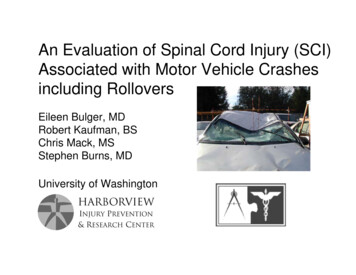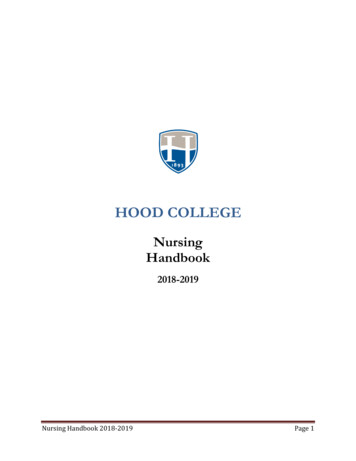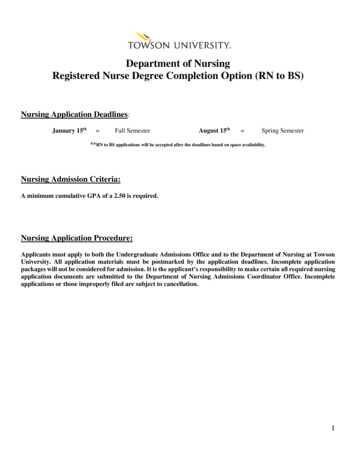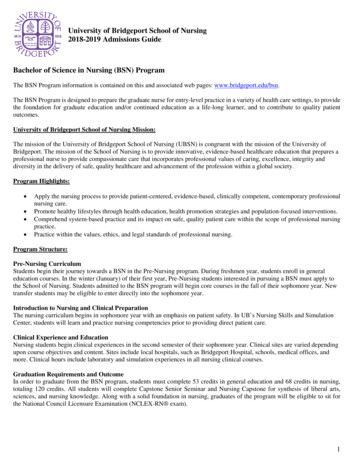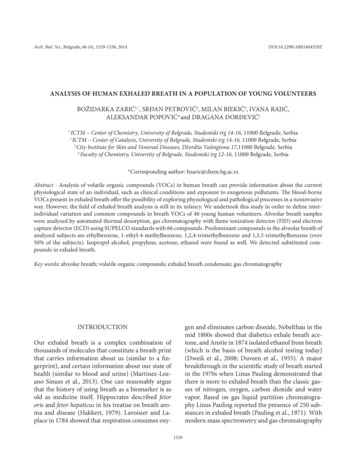
Transcription
Arch. Biol. Sci., Belgrade, 66 (4), 1529-1538, 2014DOI:10.2298/ABS1404529ZANALYSIS OF HUMAN EXHALED BREATH IN A POPULATION OF YOUNG VOLUNTEERSBOŽIDARKA ZARIĆ1,*, SRĐAN PETROVIĆ2, MILAN BJEKIĆ3, IVANA RAJIĆ,ALEKSANDAR POPOVIĆ4 and DRAGANA ĐORĐEVIĆ11ICTM – Center of Chemistry, University of Belgrade, Studentski trg 14-16, 11000 Belgrade, SerbiaICTM – Center of Catalysis, University of Belgrade, Studentski trg 14-16, 11000 Belgrade, Serbia3City Institute for Skin and Venereal Diseases, Džordža Vašingtona 17,11000 Belgrade, Serbia4Faculty of Chemistry, University of Belgrade, Studentski trg 12-16, 11000 Belgrade, Serbia2*Corresponding author: bzaric@chem.bg.ac.rsAbstract - Analysis of volatile organic compounds (VOCs) in human breath can provide information about the currentphysiological state of an individual, such as clinical conditions and exposure to exogenous pollutants. The blood-borneVOCs present in exhaled breath offer the possibility of exploring physiological and pathological processes in a noninvasiveway. However, the field of exhaled breath analysis is still in its infancy. We undertook this study in order to define interindividual variation and common compounds in breath VOCs of 48 young human volunteers. Alveolar breath sampleswere analyzed by automated thermal desorption, gas chromatography with flame ionization detector (FID) and electroncapture detector (ECD) using SUPELCO standards with 66 compounds. Predominant compounds in the alveolar breath ofanalyzed subjects are ethylbenzene, 1-ethyl-4-methylbenzene, 1,2,4-trimethylbenzene and 1,3,5-trimethylbenzene (over50% of the subjects). Isopropyl alcohol, propylene, acetone, ethanol were found as well. We detected substituted compounds in exhaled breath.Key words: alveolar breath; volatile organic compounds; exhaled breath condensate; gas chromatographyINTRODUCTIONgen and eliminates carbon dioxide, Nebelthau in themid 1800s showed that diabetics exhale breath acetone, and Anstie in 1874 isolated ethanol from breath(which is the basis of breath alcohol testing today)(Dweik et al., 2008; Duveen et al., 1955). A majorbreakthrough in the scientific study of breath startedin the 1970s when Linus Pauling demonstrated thatthere is more to exhaled breath than the classic gasses of nitrogen, oxygen, carbon dioxide and watervapor. Based on gas liquid partition chromatography Linus Pauling reported the presence of 250 substances in exhaled breath (Pauling et al., 1971). Withmodern mass spectrometry and gas chromatographyOur exhaled breath is a complex combination ofthousands of molecules that constitute a breath printthat carries information about us (similar to a fingerprint), and certain information about our state ofhealth (similar to blood and urine) (Martinez-Lozano Sinues et al., 2013). One can reasonably arguethat the history of using breath as a biomarker is asold as medicine itself. Hippocrates described fetororis and fetor hepaticus in his treatise on breath aroma and disease (Hakkert, 1979). Lavoisier and Laplace in 1784 showed that respiration consumes oxy1529
1530BOŽIDARKA ZARIĆ ET AL.(GC-MC) instruments, we can indentify more than 1000 unique substances in exhaled breath (MartinezLozano Sinues et al., 2013). These substances includeelemental gases like nitric oxide and carbon monoxide and a multitude of volatile organic compounds.Exhaled breath contains aerosolized droplets as well,called exhaled breath condensate that have non-volatile compounds like proteins in them (Horvath et al,2005; Borrill et al. 2008).With recent advances in technology, anythingin the blood that is potentially volatile or has volatile metabolites can be measured in exhaled breath.This includes substances that are produced as a partof our normal (or disease-related) metabolism. Sincewe are constantly inhaling air from our environment,exhaled air can also reflect our environmental exposure (Akmstrand et al, 2009; Dubowsky et al., 2007;Jacobs et al., 2010; Brunekreef et al. 2002). Furthermore, our breath contains volatile compounds produced by our internal environment the bacteria inour gut and mouth.The field of breath analysis is rapidly evolving asthe new frontier in medical testing for disease statesin the lungs and beyond (Amann A et al, 2007).Breath analysis is now used to diagnose and monitor asthma, various cancers like, such as lung cancer(Hakim et al., 2012), breast cancer (Phillips et al.,2010), colorectal cancer (Altomare et al.,2013), livercirrhosis (Dadamio et al., 2012), heart transplant rejection (Cikasch Jr. et al, 2012), oxidative stress (Amman et al., 2007; Phillips et al., 2003), kidney damage (Pagonas et al., 2012). Breath analysis has thepotential to offer a relatively rapid and noninvasivemethod for detecting a variety of diseases, including diabetes (Buszewski et al., 2007; Righettoni et al.,2012; Hubbard, 1920). Breath analysis has potentialto be applied in fields beyond medicine including environmental monitoring, security and others.Many VOCs are present in exhaled breath,which can reflect the current physiological state ofan individual (Martinez-Lozano Sinues et al., 2013).Changed levels and composition of VOCs in diseased patients can provide insight into abnormalmetabolism. Several VOCs can be directly linked tocholesterol metabolism in the body, with isopreneas the signature molecule (Phillips et al., 1997; Kalapos, 2003). Oxidative stress is a term referring tothe generation of reactive oxygen species (ROS) thatcatalyze the breakdown of polyunsaturated lipidsinto lipids with a carbon radical. The carbon radical then becomes a lipid peroxyl radical by combining with molecular oxygen, which can lead to thebreakdown of other polyunsaturated lipids. This typeof oxidative stress has been shown to occur in hearttransplant rejection, acute myocardial infarction andseveral respiratory diseases. Acetone is producedin the liver after degradation of acetyl coenzyme A.When the body uses fat for energy rather than glucose (during dieting, fasting or starvation), acetoneproduction increases. Endogenous reduction of acetone leads to the formation of 2-propanol, which isa VOC that can be measured in the exhaled breathat concentrations lower than acetone (Kalapos, 2003;Deng et al., 2004; Nelson et al., 1998). Benzene andacetonitrile are two VOCs that are present in elevated concentrations in individuals exposed to tobaccosmoke. Typical VOCs present in human breath areisoprene, methanol, acetone and 2-propanol. Acetonitrile, furan and 2-methylfuran have been foundin smokers, limonene is of exogenous origin, hydrogen is from bacteria in the gut of persons sufferingfrom fructose malabsorption while methane, ethaneand pentane are lipid peroxidation products (Nelsonet al., 1998; Phillips et al., 1999). Possible sources ofcancer VOCs have been reported. Metabolic disorders or pathological processes can produce newVOCs or change the ratio between VOCs producedin the body. It has been proposed that cytochromep450 enzymes are overactivated in lung and breastcancer (Phillips et al., 2007; Hakim et al., 2012).Alveolar breath is a distinctive gas whose chemical composition differs markedly from inspired air.Volatile organic compounds are either subtractedfrom inspired air or added to alveolar breath as products of metabolism (Phillips et al., 1999). Alveolarbreath samples in this study were collected using acommercial device (Bio-VOC sampler, Markes International Limited, UK) for exhaled air developed by
ANALYSIS OF HUMAN EXHALED BREATH IN A POPULATION OF YOUNG VOLUNTEERSthe UK Health and Safety laboratory. The principleof the method relies in the relationship between volatile chemical concentrations in the blood and air inthe lungs, termed end-tidal air. The concentration ofvolatile chemicals in alveolar air responds rapidly tochanges in the end-tidal air. An adult exhaling deeplytypically breathes out over 4 L of air. Only the last100 ml of this air from alveolar portion of the lungsis retained by the Bio-VOC sampler. The method issensitive with a coefficient of variation between 5%and 15% for collection and analysis of breath samples(Handerson et al., 2002). Each volunteer was askedto exhale through a cardboard mouthpiece into theBio-VOC sampler (Markes International, 2000).Alveolar breath was transferred to a sorbent trap.VOCs in the sorbent traps were analyzed by automated thermal desorption, gas chromatography withflame ionization detector (FID) and electron capturedetector (ECD).In this paper, volatile organic compounds foundin exhaled breath of 48 young (between 19 and 33years) volunteers are presented. The TD/GC/FID/ECD method was developed for the analysis of volatiles in breath. We analyzed variations in the composition and quantities of VOCs in the breath of normalyoung humans using gas chromatography combinedwith a flame ionization detector (FID) and electroncapture detector (ECD). All of them had fasted fromthe previous midnight in order to minimize any potential confounding effects of recent meals. The studyparticipants refrained from smoking, eating, teethbrushing and chewing gum for at least 2 h prior tothe analysis. Subjects generally sat for approximately15 min prior to collection of breath and air in orderto allow time for equilibration between the VOCs inroom air and blood. All volunteers were asked to fillin a questionnaire describing their current smokingstatus, drinking status and status of health, based onself-declaration.MATERIALS AND METHODSExhaled breaths of forty-eight subjects (between 19and 33 years) were analyzed. None of the volunteerscomplained of discomfort during donation of the1531breath sample. Alveolar breath samples were collected using a commercial device (Bio-VOC sampler,Markes International Limited, UK). Each subjecthad to keep exhaling until the lungs were emptied,thereby capturing the end-tidal air. Once the breathhad been collected in the Bio-VOC sampler, a screwin plunger was used to steadily discharge the sampleinto a concentrating (sorbent) trap, a sampling tube.Alveolar breath was transferred immediately fromthe sampler to the sorbent tube containing 200 mgTenaxTA and 200 mg Unicarb (carbonized molecularsieve) (Markes International Limited). The samplingtube was then capped and was stable for transportation and subsequent analysis by gas chromatography. Samples were analyzed using TD/GC/FID/ECD(Agilent 7890) associated with the thermal desorber(Unity MARKES 1). Separation of the componentswas performed on a capillary column DB-624, 60m in length. TD/GC/FID/ECD was previously calibrated with 66 compounds contained in SUPELCOstandard Cat. No. 41973-U balanced in nitrogen.Compounds present in each sample were quantifiedaccording to the prepared standard curve.RESULTS AND DISCUSSIONHuman subjects were volunteers recruited from faculty colleagues and young faculty staff. There were48 subjects studied, 16 males and 32 females, agedbetween 19 and 33 years. The subjects remained inthe same room for at least 15 min before breath collection so that equilibrium between the lung and ambient air was created.Human subjects’ etiology and study designThe average age of the subjects was 25.6 years. Theresearch was approved by the Faculty Review Board.Among the subjects there were 2 persons whohave hypertension, none had diabetes, and 4 hadhigh values of lipids in the blood. Forty-two subjectshad normal values of blood pressure, levels of sugarand lipids in blood, 29 were females and 13 males. Sixof the subjects had a chronic problem (high values oflipids in blood, hypertension) or more than one con-
1532BOŽIDARKA ZARIĆ ET AL.Table 1. Characteristics of the study populationGroup etiologyNumberFemale/maleHealthy 1110/1Drinkers3220/12Fats in blood43/1Table 2. Variation in the number of volatile organic compounds identifiedBreath VOCRange of concentrationsNumber of(per 1lof alveolar breath in μg) subjectsPropylene5.72 10-31Ethanol1.16 10-2-6.83 10-411Acetone1.12 10-2-9.90 10-3191,3-ButadieneCarbon disulfide4.46-8.71 105Isopropyl alcohol9.92 10-3-5.68 10-43Tert-butyl methyl ether11.21 10-1-6.84 10-211n-Hexane1.15 10-1-5.12 10-310Vinyl acetate2.73 10 -6.20 1032-butanone2.06 10-1-9.18 10-39Ethyl acetate1.06 10-1-7.51 10-36Tetrahydrofuran8.73 10-2-8.62 10-46Ciklohexane4.85 10-2-1.43 10-36Benzene1.04 10-2-6.37 10-412Heptane1.29 10-2-8.43 10-4141,4-Dioxane4.40 10-1-9.83 10-322-4-1-3Methyl isobutyl ketone11.18 10 -2.65 105Toluene1.81 10-4-2.19 10-42n-octane1.22 10-2-4.90 10-416Methyl n-Butyl ketone1.41 10 -1.80 109Ethylbenzene3.66 10-2-8.40 10-59m-Xylene1.48 10-2-1.48 10-227Nonane91.21-9.24 10-119p-Xylene8.42 10 -5.94 1019o-Xylene1.02 10-1-9.87 10-27Styrene1.00 10-3-7.94 10-313n-Decane1.76 10-2-8.19 10-4221-Ethyl-4-methylbenzene1.04 10 -6.00 10271,2,4-Trimethylbenzene1.36 10-2-9.83 10-4371,3,5-Trimethylbenzene1.02 10-2-8.74 10-443-3-3-1-3-3-4-4-4
ANALYSIS OF HUMAN EXHALED BREATH IN A POPULATION OF YOUNG VOLUNTEERS1533Fig. 1. The frequency of detection of compounds in the analyzed populationdition at the same time. More than two-thirds of thesubjects (67%) consumed alcohol to some extent. Six(3 females and 3 males) consumed alcoholic drinkstwo or three times a week, 16 consumed alcohol twoor three times a month (9 females and 5 males), 10rarely consumed alcoholic beverages (5 females and5 males). Eleven subjects smoked, 10 females and1 male. The extent to which the subjects consumedcigarettes varied from 20 cigarettes (1 male) to 2cigarettes per day (1 female); 3 females consumed10 cigarettes per day. Seven persons practiced someform of recreation (athletics, fitness), 2 females and5 males. Four persons consumed some type of prescribed medication (for migraine, anemia, depression and asthma). These conditions were in normalvalues at the moment of sampling.The column used in this study was calibratedwith 66 compounds. The system TD/GC/FID/ECDwas also calibrated with 36 compounds substitutedwith Br or Cl contained in the calibration mixture,and compounds present in each sample were quantified according to the standard curve.In earlier reports on breath samples of healthypersons, acetaldehyde, ethanol, acetone, 2-methyl1-propene, carbon disulfide, isoprene, pentane, 2and 3-methylpentane, hexane and toluene are usually identified. Compounds such as ethanol, acetone,isoprene, carbon disulfide, 2- and 3-methylpentane,benzene, methylcyclopentane, hexane and toluenewere found in all breath samples (Buszewski et al.,2009; Phillips, 1999; Phillips et al., 1999). Ethanol,acetone, carbon disulfide, isoprene and hexane areendogenous and the remaining compounds are exogenous.In Table 2 and Fig. 1 it can be seen that the mostabundant volatile organic compounds in exhaledbreath of young population were 1-ethyl-4-methylbenzene, 1,2,4-trimethylbenzene, 1,3,5-trimethylbenzene, found in over 50% of subjects. Benzene waspresent in a lower number of subjects (24.5%), probably due its modification in the above-mentionedcompounds. In previously published studies, benzene was present in the exhaled breath of smokers,non-smokers and passive smokers, but it has been
1534BOŽIDARKA ZARIĆ ET AL.Table 3. Substituted compounds in breathChlorinated breathRange of concentrationsVOC(per 1l of alveolar breath in μg)Dichlorodifluoromethane/Numberof subjects//1,2-Dichlorotetrafluoroethane/Vinyl chloride1.01 10-3-1.27 10-6Bromomethane1.57 10 -9.13 1010Ethyl chloride7.65053-7.21 10-216Trichlorofluoromethane1.54254-7.98 10-312Ethylene 1.2-dichloro (trans)1.44 10-1-3.21 .47 1013Methyl chloride1.78 10-1-8.92 10-511Methylene chloride1.05 10-1-9.42 10-610Cis-1.2-Dichloroethylene3.08803-5.47 10-471.1-Dichloroethane3.17 10-1-8.20 10-4141.1-Dichloroethylene1.13 10-1-8.16 10-313Chloroform1.95 10-3-1.79 10-441.1.1- Trichloroethane1.75 10-4-5.49 10-65Carbon tetrachloride1.55 10 -8.49 10181.2-Dichloroethane6.59 10-3-9.48 10-520Trichloroethylene1.10 10-2-2.67 10-5271.2-Dichloropropane1.94 10-41Bromodichloromethane1.23 10-2-9.79 10-37Cis-1.3-Dichlorpropane1.32 10-2-1.40 10-56Trans-1.3-Dichlorpropene1.80 10-2-8.17 10-5238-4-4-61.1.2-Trichloroethane1.21 10 -4.97 10Tetrachlorethylene1.19 10-1-8.57 10-517cis-1.2-Dichloroethylene1.01 10-4-5.70 10-56Dibromochloromethane1.33 10-2-5.83 10-5141.2-Dibromoethane1.87 10 -3.97 1042Chlorobenzene6.20 10-2-9.64 10-515Tribromomethane1.24 10-2-4.79 10-471.1.2.2-Tetrachloroethane3.74 10-2-8.06 10-4491.3-Dichlorobenzene1.26 10 -8.67 10391.4-Dichlorobenzene2.40778-6.76 10-736Benzyl chloride2.26 10-3-5.75 10-5111.2-Dichlorobenzene3.51 10-1-5.14 10-643Hexachloro-1-3-butadiene2.59163-6.35 10441.2.4-Trichlorobenzene2.53 10-2-9.87 10-537-4-5-2-5-2-5-3confirmed that its origin is exogenous. Ethanol, acetone and isopropyl alcohol, which are usually foundin exhaled breath, were present in a lower percentage of the analyzed population. Ethanol and acetonewere present in over 20% of the volunteers, whereasisopropyl alcohol was present in only 6.1%. A peakcorresponding to 1,3-butadien was not found in theanalyzed population, where propylene was found inonly one person.
ANALYSIS OF HUMAN EXHALED BREATH IN A POPULATION OF YOUNG VOLUNTEERS1535Fig. 2. The frequency of detection of substituted compounds in the analyzed populationVinyl acetate, ethyl acetate and tetrahydrofuranwere present in 3 and 6 persons, respectively, whichsuggests that this may be of exogenous origin. Toluene was found in two persons. There are reports thatshow a connection between furan, octane and decane in the breath of smokers and passive smokers.In our study, we could not find a significant connection between smoking and the existence of octane,decane or nonane, although all three compoundswere present in over 30% of the analyzed subjects.Tetrahydrofuran was present in 6 samples whichcannot be connected to smoking. However, furtherstudies need to confirm these findings. In our analyzed samples, styrene, p-xylene, and o-xylene werepresent as well, but based on published data, we canconclude that their origin is exogenous (Buszewskiet al., 2009).In this study, chlorinated compounds (withthe exception of dichlorodifluoromethane and1,2-dihlorotetrafluoroetan) were detected in theexhaled breath of the studied population (Table 3,Fig, 2.) Almost all of the 36 listed compounds werepresent in the exhaled breath of some subjects. Somecompounds, like 1,1,2,2-tetrahloroetan, 1,2-dibromoethane and hexaclor-1-3-butadiene, were foundin more than 90% of the population. Compoundslike trichloroethylene, dichlorobenzene and 1,2,4trichlorobenzene are present in over half of the volunteers. To our knowledge, this is the first report thatconsiders the existence of substituted volatile organiccompounds in human breath that is not the resultof previous exposure to these substituted hydrocarbons. Methylene chloride was previously reportedin human breath, but the authors assumed that itsorigin was exogenous (Buszewski et al., 2009). Thisresult requires further detailed investigation. A typical recorded chromatograms showing exhaled breathprofile is shown in Fig. 3.
1536BOŽIDARKA ZARIĆ ET AL.VOCs that are associated with normal human breath.Separation of the components was performed on a60 m capillary column DB-624. The earliest and stillmost widely used application of breath VOC analysis is the monitoring of blood alcohol concentration.Since ethanol is not normally present in ambientair, ethanol detected in the breath can be assumedto originate from the body. Only the most abundantbreath VOCs, like ethanol, acetone and isoprene,were detected with assays of unconcentrated breath.However, many of the human breath VOCs can bedetected in normal room air. Thus, researchers arefaced with a dilemma: does VOC originate fromwithin the body or is it an artifact due to contamination from environmental air? Some researchers haveresponded to this issue by ignoring the problem.Some authors provided the subject with VOC-freeair to breathe prior to collection of breath sample.This is not possible to achieve in practice, becausehigh purity air also contains VOCs in low concentrations. Some researchers measure background airand subtract from the VOCs observed in the exhaledbreath.In some studies, human subjects remain in thesame room for at least 10 min before breath collection so that equilibrium can be created between lungand ambient air. We elected to follow the last option,and to calculate the concentrations of compounds inexhaled breath based on a calibration curve.Fig. 3. Typical chromatogram of alveolarbreath sample (red linerepresents electron capture detector and blue line flame ionizationdetector)The present work shows that breath analysis byTD/GC/FID/ECD (Agilent 7890) is able to identifyBenzene, toluene, styrene and 2,5-dimethylfuranare present. Styrene is considered exogenous. Sources of exhaled breath compounds need not be limitedto human physiology. As stated previously, bacteriain the gut and mouth can often be sources of manyvolatile compounds in the breath (Buszewski et al.,2009). Hydrogen sulfide is a by-product of bacterialmetabolism in the mouth and can be a sign of periodontal disease. Elevated levels of the compound havebeen observed in exhaled breath, and these levels canchange significantly after a simple mouth rinse. In addition to VOCs produced within the body, exogenoussources of compounds need to be considered as well.Many compounds measured in exhaled breath occurafter ingestion of certain foods and beverages (etha-
ANALYSIS OF HUMAN EXHALED BREATH IN A POPULATION OF YOUNG VOLUNTEERSnol or nitrogen oxide) or inhalation of car exhaustgases and cigarette smoke. Benzene and acrylonitrileare two VOCs that are present in elevated concentrations in individuals exposed to tobacco smoke. Thelarge majority of both compounds are conjugated bythe cytochrome P450 enzymes in the liver and excreted in the urine; however, the rest is exhaled in thebreath unchanged. The ability to monitor the smoking habits or exposure of subjects could provide evidence that lifestyle changes must occur to limit theirexposure to cigarette smoke pollutants. Exogenoussources include exposure to cigarette smoke, alcohol,pollution and radiation.According to our standard curve, nonane waspresent in highest concentrations in 19 individuals.Based on literature data, nonane has an exogenousorigin (Buszewski et al., 2009). Propylene, ethanoland isopropyl alcohol were present as well in highconcentrations in some subjects. The usual measuredconcentrations are in accordance with nanomolar orpicomolar concentrations measured by other authors.CONCLUSIONSBreath samples of healthy young population ofvolunteers were analyzed. More than 50% of thesubjects exhaled ethylbenzene, 1,2,4-trimethylbenzene, 1,3,5-trimethylbenzene and 1-ethyl-4-methylbenzene, which is probably the result of internalmodification of benzene which is assumed to be anexogenous pollutant. The usual exhaled volatile organic compounds such as isopropyl alcohol, propylene, acetone and ethanol were detected as well. Themost common identified exogenous compounds,xylene isomers, styrene and furan derivatives, werefound as well. In this preliminary investigation, wefound 34 substituted compounds in lower or higherfrequency of occurrence. Some of the compoundslike 1,1,2,2-tetrachloroetane, 1,2-dibromoethaneand hexachloro-1,3-butadiene, were found in morethan 90% of the population. The presence of notpreviously detected substituted compounds in exhaled breath of humans requires further detailedinvestigation.1537Acknowledgments - This work was supported by Grant No.172001 from the Ministry of Science and Education, Republic of SerbiaREFERENCESAlmstrand, A.C., Ljungstrom, E., Lausmaa, J. et al. (2009). Airwaymonitoring by collection and mass spectrometric analysisof exhaled particles. Anal Chem.81:662-668.Amann, A., Spanel, P. and Smith, D. (2007). Breath analysis:the approach towards clinical application. Mini Rev MedChem 7:115-129.Altomare, D.T., Di Lena, M., Porcelli, F. et al. (2013). Exhaledvolatile organic compounds identify patients with colorectal cancer British Journal of Surgery.100:144-150.Borrill, Z.L, Roy K. and Singh D. Exhaled breath condensate biomarkers in COPD (2008) Eur Respir J .32: 472-486.Brunekreef, B. and Holgate, S.T. (2002) Air pollution and health.Lancet. 360:1233-1242.Buszewski, B., Kèsy, M., Ligor, T. and Amann, A. (2007) Humanexhaled air analytics: biomarkers of diseases. BiomedicalChromatography 21: 553-566.Buszewski, B., Ulanowska, A., Ligor, T. et al. (2009) Analysis ofexhaled breath from smokers, passive smokers and nonsmokers by solid-phase microextraction gas chromatography/mass spectrometry Biomed. Chromatography; 23:551-556.Cikasch, F.S. Jr., and Dweik RA. (2012). Cardiovascular Biomarkers in Exhaled Breath. Prog Cardiovasc Dis. 55:34-43.Dadamio, J., Van den Velde, S., Laleman, W. et al. (2012). Breathbiomarkers of liver cirrhosis. Journal of ChromatographyB 905:17-22.Deng, C.H., Zhang, J., Yu, X.F., Zhang, W. and Zhang, X.M.(2004) Determination of acetone in human breath by gaschromatography-mass spectrometry and solid-phase microextraction with on-fiber derivatization J. Chromatogr.B 810: 269-75Adar, S.D., Adamkiewicz, G., Gold, D.R. et al. (2007). ambientand microenvironmental particles and exhaled nitric oxide before and after a group bus trip Environ Health Perspect 115:507-512.Duveen, D.I. and Klickstein, H.S. (1955). Antoine LaurentLavoisier’s contributions to medicine and public healthBull. Hist. Med. 29: 164-79Dweik, R.A. and Amann, A. (2008): Exhaled breath analysis: thenew frontier in medical testing . J Breath Res 2: 3pp
1538BOŽIDARKA ZARIĆ ET AL.Hippokrates Oeuvres Completes d’Hippocrate A. Littre. Amsterdam: Adolf M.Hakkert (1979) 4, 17.born infants and in children with diabetes mellitus Pediatr.Res. 44: 363-7.Hippokrates Oeuvres Completes d’Hippocrate A. Littre. Amsterdam: Adolf M.Hakkert (1979) 5, 11.Pauling, L., Robinson, A.B., Teranishi, R. and Cary, P. (1971).Quantitative analysis of urine vapor and breath by gasliquid partition chromatography Proc. Natl Acad. Sci. USA68: 2374-6.Horváth, I., Hunt, J., Barnes, P.J. et al. (2005) Exhaled breathcondensate: methodological recommendations and unresolved questions Eur. Respir. J. 26(3): 523-48.Hakim, M., Broza, Y., Barash, O. et al. (2012) Volatile organiccompounds of lung cancer and possible biochemical pathways Chemical Reviews. 112(11): 5949-66.Hubbard, R.S.(1920) Determination of acetone in expired air J.Biol. Chem. 43: 57-65.Henderson, K.A. and Matthews, I.P. (2002) Biological monitoringof midwives’ exposure to N2O using the Bio-VOC breathsampler Journal of Exposure Analysis and EnvironmentalEpidemiology 12: 309-312.Lotte, J., Nawrot, T.S., De Geus, B. et al. (2010) Subclinical responses in healthy cyclists briefly exposed to traffic-relatedair pollution: an intervention study. Environmental Health9:64-69.Pagonas, N., Vautz, W., Seifert, L. et al. (2012). Volatile organiccompounds in uremia. PloS ONE 7(9):e46258.Phillips, M., Cataneo, RN., Saunders, C. et.al. (2010) Volatilebiomarkers in the breath of women with breast cancer. J.Breath Res 4 :8 pp.Phillips, M., Cataneo, RN., Greenberg, J. et al. (2003) Effect ofoxygen on breath markers of oxidative stress. Eur RespirJ. 21:1-5Phillips, M., Herrera, J., Krishnan, S. et al. (1999) Variation involatile organic compounds in the breath of normal humans. J Chromatogr B Biomed Sci Appl 729:75-88.Phillips, M. (1997).Method for the collection and assay of volatile organic compounds in breath Analytical Biochemistry247:272-278.Kalapos, M. P. (2003) On the mammalian acetone metabolism:from chemistry to clinical implications Biochim. Biophys.Acta Gen. Subj. 1621 :122-39.Phillips, M., Altorki, N., John, H.M. et al. (2007). Prediction oflung cancer using volatile biomarkers in breath CancerBiomarkers 3 :95-109.Martinez-Lozano Sinues, P., Kohler, M. and Zenobi, R. (2013).Human breath analysis may support the existence of individual metabolic phenotypes. PLoSONE 8(4): e59909.Righettoni, M., Tricoli, A., Gass, S. et al. (2012) Acetone monitoring by portable Si: WO3 gas sensors. Analytica ChimicaActa 738: 69- 75.Nelson, N., Lagesson, V., Nosratabadi, A.R., Ludvigsson, J. andTagesson, C. (1998) Exhaled isoprene and acetone in new-
Diabetes 0 0/0 Smokers 11 10/1 Drinkers 32 20/12 Fats in blood 4 3/1 Table 2. Variation in the number of volatile organic compounds identified Breath VOC Range of concentrations Number of (per 1lof alveolar breath in μg) subjects P
